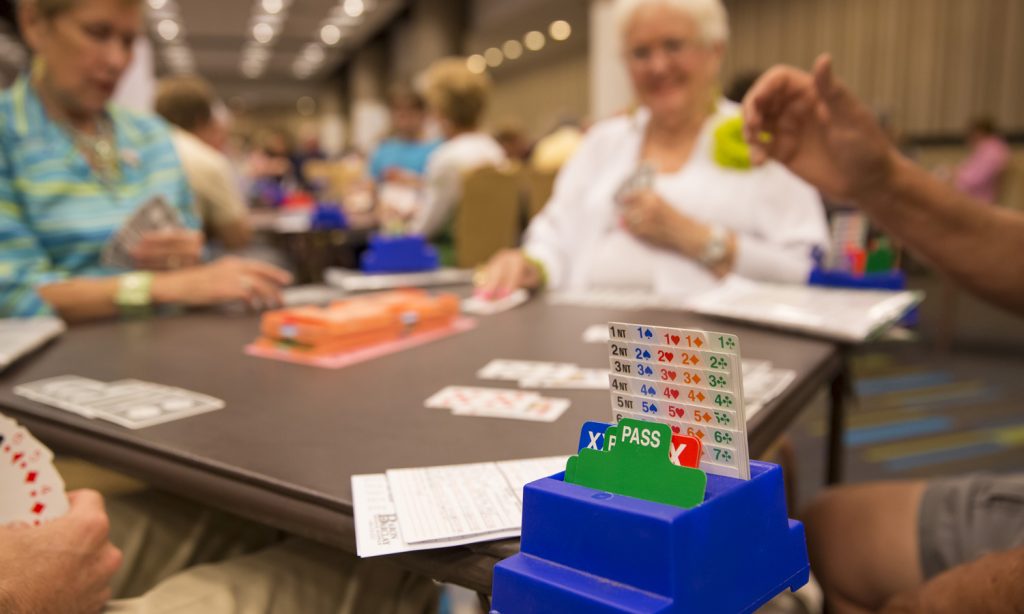Did you just see someone cheat at bridge? Or worse, did someone just accuse you of cheating? As you can expect, this is a very sensitive topic and newcomers to the game will appreciate an introduction to cheating at bridge.
A Look at Cheating

Putting the Spotlight on Cheating
by Alex J Coyne. © 2016 Great Bridge Links
Did you just see someone cheat at bridge? Or worse, did someone just accuse you of cheating? As you can expect, this is a very sensitive topic and newcomers to the game will appreciate an introduction to cheating at bridge. What’s it all about?
Bridge made international news when the Israeli players Loran Fisher and Ron Schwartz were accused of cheating by their fellow teammates in August 2015 and that news rocked the bridge world. One year later they were officially expelled from the American Contract Bridge League, surrendering the Spingold Trophy, Reisinger Trophy and North American Swiss. Over the history of bridge there have been many others – some cheating has been subtle and other times not so much. Players Alan Cokin and Steven Sion were caught out in the late ’70’s using illegal signals with their pencils during the game and were expelled from the American Contract Bridge League.
In 2000 John Bubaugh was accused of handing his partner choice cards when acting as the dealer. He was quickly hit with a suspension by the American Contract Bridge League. In 2014, two German physicians, who had won a World Pairs Championship, were banned for ten years by the World Bridge Federation for using an auditory signalling system. (They’re now known as the Coughing Doctors – see article on The Guardian here)
In 1965, the bridge world was rocked by an accusation of cheating at the world championships in Buenos Aires. The pair involved were Britain’s Terence Reese and Boris Schapiro, two of the world’s best players (and authors) who were allegedly holding their cards in unusual ways during bidding to communicate how many hearts were in their hand. While there was direct evidence of this, it was insufficient to find them guilty beyond a doubt. Years later, it was revealed that Reese had admitted to someone that they were indeed using hand signals but only as part of research for a book they were writing on – you guessed it – cheating at bridge. This confession was published after their deaths.
These are only a few of the more famous stories. Cheating, and the invention of complicated cheating systems, is not meant to be part of the game of bridge, but many have risked their careers indulging in the challenge.
But not all cheating is on purpose.
By the Rules
So, just what constitutes a cheat? Not all cheats are outright, and not all rule violations are on purpose! To protect you from cheating inadvertently, here are a few of the applicable laws according to the 2007 Edition Laws of Duplicate Bridge and what they mean to the game:
– LAW 6: THE SHUFFLE & DEAL
(D) A re-shuffle is required should any player, accidentally or purposefully, spot the cards of another player. It remains within the rules if this is reported immediately, and the cards are shuffled and dealt again.
Note: This would not apply to ‘duplicate’ bridge where all the hands are pre-dealt. In this case, players at the table should call a director.
– LAW 16: AUTHORIZED & UNAUTHORIZED INFORMATION
(B): Extraneous Information from Partner
Rule 1(a) makes it clear that absolutely no signals should be given to another player to indicate the meaning of a bid or play. This is considered downright cheating, and seems to be one of the most common kinds. Signals can be varied – from the way a player touches their hair or holds their cards, to asking his or her partner a specific question to tip them off about their hand, but all deliberate signals are prohibited. Even an undue hesitation in the bidding could pass information to your partner and whether or not you meant to ‘cheat’ you could be called on it.
– LAW 73: COMMUNICATION
(B): Inappropriate Communication from Partner
Here, rule number 2 prohibits exchanging any kind of pre-arranged information about the game between partners. Funnily enough, most new players go though a stage where they think it might be cool to have special bids that hold secret meanings known only to them and their partner. This is not allowed – all bids and their meanings must be available to everyone at the table. Convention cards and alerts and even pre-alerts are ways organizers ensure everyone at the table knows what’s going on during the bidding.
– LAW 90: PROCEDURAL PENALTIES
(B): Offenses Subject to Procedural Penalty
Law 90 covers any other plays that might get in the way of the game – again, some outright cheating and some bordering on a grey area. More specifically during duplicate tournament play (where everyone plays the same hands), (B)2. prohibits unnecessarily slow play – thus, someone trying to extend a game by playing on a go-slow. Number (B)3. prohibits giving out information about the result, bidding or play of the game to other players. (B)4. stops players from comparing their scores before the game has ended. And, of course, number (B)5. says: Don’t touch or handle another player’s cards!
Are there ways to prevent cheating?
In the world of tournament bridge, there have been many innovations in an attempt to curtail cheating. One is the invention of the Bidding Box, invented in Sweden in 1962 and first used in a World Championship in 1970. Today Bidding boxes are used in all duplicate play and at many home games as well. Rather than saying a bid out loud, players pull a bid card from the box. This invention puts an end to all the ‘accidental’ information conveyed to partner by the tone of a player’s voice, or the forcefulness of the bid. However, I’ve seen some pretty forceful DOUBLE cards slapped to the table – so bidding boxes alone were not enough.
Other innovations include Table Screens and Table Trays, video surveillance, and more. Watch for a future blog post that will address these items in more detail.
Could you spot a cheat?
You know the rules and you’re absolutely convinced your opponents couldn’t possible have bid or made that hand without some kind of unlawful knowledge. What do you do?
There are proper avenues for reporting your suspicions.
What you should not do is accuse anyone of cheating – either to their faces or behind their backs.
Proving someone is a cheater is very difficult. Boye Brogeland, the person who exposed Loran Fisher and Ron Schwartz studied many videos and set up a website (http://bridgecheaters.com/) to examine the evidence. However, this is not recommended for most of us and indeed Brogeland is currently being legally challenged on various fronts.
If you have concerns about cheating at your table or at your bridge club, start by talking privately with the director in charge. They will advise you of your next steps.
At ACBL (American Contract Bridge League) tournaments or unit events, there is a Recorder on hand. Recorders are specially trained people who will receive and record your complaint. If there is no Recorder around, there will be a Recorder Box. Fill out the slip and drop it into the box. Recorders do not take action, other than to pass your complaint or report on to the appropriate authorities. If those authorities have received similar complaints, action will be taken. Read more about Recorders on the ACBL Website
And stating the obvious, if you have concerns about cheating at a home game or party bridge, let it go!
About the author: Alex J Coyne is a freelance journalist, author and language practitioner. Sometimes, he’s got an ace up his sleeve and a Joker in his hat. He can be found at his blog. alexcoyneofficial.wordpress.com








